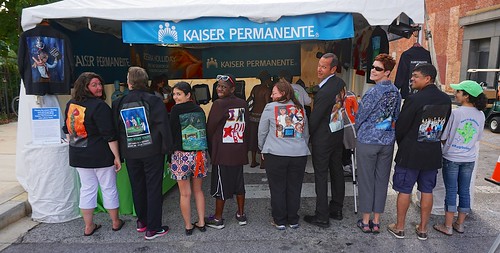I’ve never missed a yearly Walking Gallery of Healthcare event, now in its fourth year, phew!
This year’s was especially cool because it was sponsored by Kaiser Permanente Mid-Atlantic States (@KPMidAtlantic) at Baltimore, MD’s Artscape 2014 (see: Regina Holliday’s Medical Advocacy Blog: The Walking Gallery at #Artscape2014). This kind of support may seem like the obviously cool thing to do in 2014, however, I remember the days when people asked me, “how did you meet this Regina Holliday person again?” and the reaction being a mix of surprise and impressed-ness when the answer wasn’t “at a medical meeting somewhere.”
Now I am joined by doctors and nurses (and their children) in walking. Witness Michael Dias, MD, Permanente surgeon and Baltimore Physician in Chief for Kaiser Permanente Mid-Atlantic States (@KPMidAtlantic), whose daughter Olivia painted a beautiful jacket with her health story.
Since last year, the event itself is smaller, but the movement is not.
@tedeytan there are now 341 jackets in #theWalkingGallery 🙂 and 309 member walkers and 34 artists
— Regina Holliday (@ReginaHolliday) July 21, 2014
There is as much interest in my walking jacket(s) today when I wear them as there was when I first got them. People who see me remember my jacket from the last time they saw me, sometimes a year before. They are still among my most prized possessions – the other funny quote I remember from way back when was when someone said something to the effect of, “so you lost a jacket in this whole painting business,” and I was thinking, “I actually gained my best jacket in this painting business.” You can read about my jackets here.
I wore my jacket when I gave this talk just a few months ago: Presentation: Being a Transgender Ally and Unconscious Bias | Ted Eytan, MD. This demonstrates to me that the work to involve and respect the people we serve keeps changing and is at the same time ever-present. It will never go away, and that’s fine with me. What else are we here for in health care 🙂 .
I get to partner with my colleague Carol Cain, PhD (@ccain) to give a guest lecture at the Stanford University Division of Bioinformatics next week (Stanford University Biomedical Informatics 207), and in putting that together, have been looking for examples where HIT improves health for people, communities, and society. I was reminded in Baltimore about the need for Health IT to improve health and health care not just by lowering blood pressure and cholesterol, but by lowering anxiety, fear, information divides between physician/health system and patient/society. What else are we here for in health information technology 🙂 .
